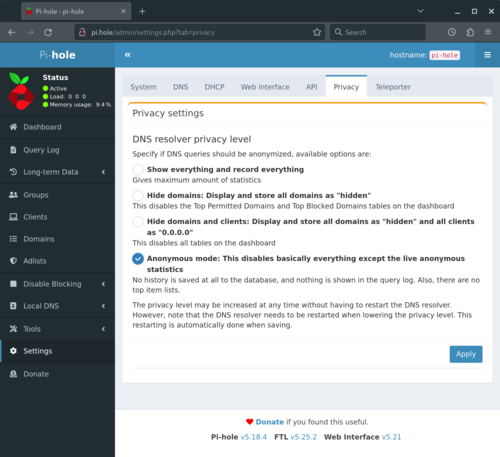Some Information might be out-of-dated
About Pi-Hole
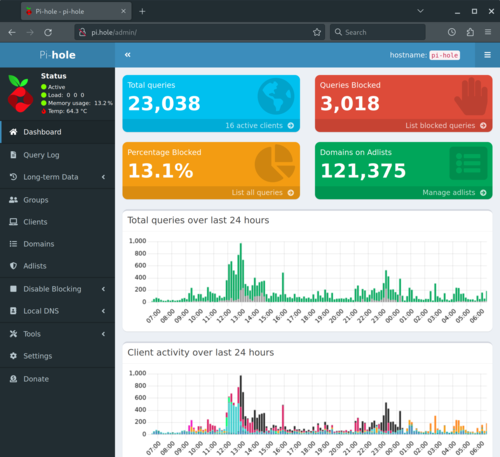
Pi-Hole
Pi-Hole is an implementation of a DNS sinkhole for small networks, licensed under the EUPL, consisting of its own FTLDNS forked from dnsmasq and a small WebUI.
It is a software that allows you to block ads in your entire home network.
Although it is being developed as an ad blocker, it can also be used as a simple cache DNS server because the domains to be blocked are completely up to you.
Motivation
I sometimes feel out of touch with the world at large when I completely block ads on the Web.
Recently, I was shocked when I was shown my father’s smartphone. An unusual amount of ads filled 2/3 of the screen, and I had to look for a space to tap to scroll. Not only the quantity, but also the content was problematic; I would literally go crazy if I had to look directly at that kind of stuff every day.
But he is stubbornly refusing to use an ad blocker. I think he is rather IT literate because he has worked in the telecommunications industry for many years, but it may be because of his sense of duty. But even if he has a strong sense of duty, is there any room for compassion in the current state of Web advertising business? They deceive and intentionally harm the viewer, wasting time and computing resources.
If they have the freedom to business, we have the freedom to choose what we see.
I decided to take a measure upstream of the network. This is because I have a de facto control of the network at my parents’ house.
Envoronment
Network
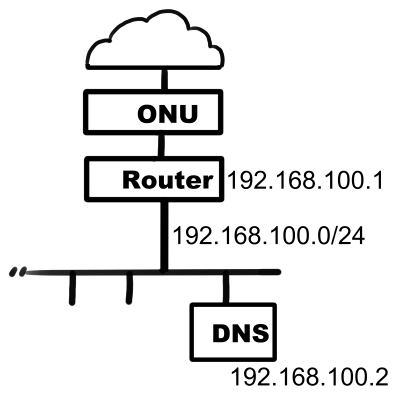
Only the DNS function of Pi-Hole will be enabled, and the DHCP server will not be enabled.
The router is a Yamaha NVR700W, connected directly from the gateway provided by NTT, and I am considering applying to NTT to switch to the latest SFP+ type small ONU.
I decided to connect to the L2 switch directly under the router because it is not good to be too far away from the router. The machine needs to be fanless for the quiet living room.
Computer
I use HP t420 Thin Client that I bought in Akihabara1.
Thin clients are getting to be out of fashion these days, but they often have low-energy CPUs and are highly reliable because they are for industrial use. If you looking for a small server computer, I recommend them rather than RPi or cheap mini-PCs. Not to mention, they’re reasonable.
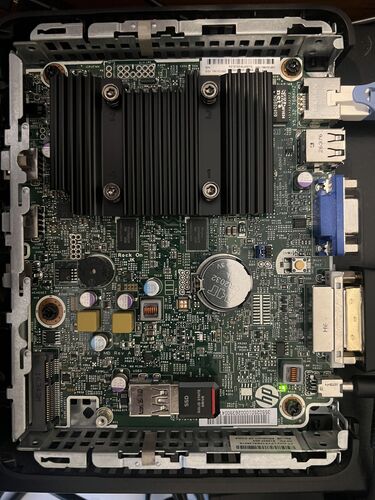
t420 interior
2GB of RAM is onboard and not expandable.
The miniPCIe port is unfortunately not in full-spec and does not support mSATA SSDs.
The USB SSD is SSD-PSTA/N which I got at Akihabara. It was twice the price of the t420. I DO NOT recommend installing on a USB flash drive because I/O speed is important.
I chose Debian for the OS, which is officially supported, and install directly without Docker to make it a dedicated machine.
Debian GNU/Linux 12 (bookworm)
AMD GX-209JA
2GB RAM
256GB USB SSD
According to the official document, 512MB RAM and 2GB disk space are the minimum requirement so RPi Zero 2 W is also enough. How lightweight!
Install
Proceed Linux installation as usual. This time, I named the
host pi-hole, but be careful NEVER to use
pihole as the user name because a user:group
named pihole:pihole will be created later.
Fix IP address
Before installing Pi-Hole, it is necessary to fix an IP address on the network interface.
You can fix an IP address by changing the router’s
configuration to associate the MAC address with the IP
address. (This function is provided by DHCP server, but most
home routers are also responsible for it). Small network like
this case, it is also possible to set a fixed IP address
outside the DHCP distribution range on your own. In the case
of my parents’ home, the DHCP distribution range is set to
192.168.100.30 ~ 192.168.100.191, so
I can use 192.168.100.2 ~
192.168.100.29 as I like.
On Debian, fix the IP address by changing dhcp
to static in
/etc/network/interfaces.
# This file describes the network interfaces available on your system
# and how to activate them. For more information, see interfaces(5).
source /etc/network/interfaces.d/*
# The loopback network interface
auto lo
iface lo inet loopback
# The primary network interface
allow-hotplug enp1s0
iface enp1s0 inet static
address 192.168.100.2
netmask 255.255.255.0
gateway 192.168.100.1
# This is an autoconfigured IPv6 interface
iface enp1s0 inet6 autoIf you manage network by other methods like
nmcli, leave minimum config.
auto lo
iface lo inet loopbackIf your upstream DNS server supports IPv6, you can enable
IPv6. I left it at auto as I don’t think IPv6 is
something to be fixed and used. You had better block
connections from outside of the home network to WebUI, SSH,
etc. with a firewall.
Run installer
According to the official document, there are three methods and Docker are presented, all of which are almost the same at the point of running the installer. If you want to take the most cautious way, I recommend “git clone” or “wget”.
It will not function as a DNS unless you change the router settings, so you can put off the detailed settings until later. After installation, you will be issued a WebUI password, which you should write down (you can also change it from the command line).
WebUI can be accessed at http://pi.hole/. If
you just put pi.hole in the address field of your
browser, it is often searched, so you need to put it in the
hosts file or start typing from
http:// in the address field. mDNS or IP address
directly typed will not be redirected to the login page for
some reason, so use http://pi-hole.local/admin or
http://192.168.100.2/admin.
Set up upstream DNS
Pi-Hole does not have a way to “automatically set the upstream DNS server to an address delivered by the provider via DHCP”, so the address must be specified directly.
There are many articles recommending open resolvers such as
Google’s 8.8.8.8, 8.8.4.4,
Cloudflare’s 1.1.1.1, 1.0.0.1, etc.
However, open resolvers are often considered a problem
themselves, so I think it is better to specify the DNS from
the provider. I personally dislike Big Tech, which does not
even try to hide its ambition to dominate the Internet, but I
also think that any service provided free of charge, not only
DNS, always takes something in return, including users’
information. However, there are some who say that
providers’ DNS is so lame that they change it for performance,
and Japanese ISPs, especially three of NTT Group companies,
have carried out the DNS blocking, I’m not
inclined to speak ill of them2.
Set Pi-Hole as a DNS
After you do this, Pi-Hole will start working as a cache DNS server.
If you have a general home router, you can specify the
address of Pi-Hole (192.168.100.2 in this case)
in the DNS configuration.
In case of Yamaha’s NVR, execute
dns server 192.168.100.2 and
dns notice order dhcp server me by running the
command, because just specifying the relay destination DNS
server from GUI generates extra traffic3. So, it is necessary to
distribute the address of Pi-Hole by DHCP for efficient
network construction. By setting server me, I
have NVR700W’s DNS server as a backup in case Pi-Hole goes
down4. As long as I do this, I
don’t have to touch any of the settings on my PC or phone. If
you check the DNS from the “Network Settings” on your phone or
PC and it is in the order of
192.168.100.2 192.168.100.1, it is a great
success.
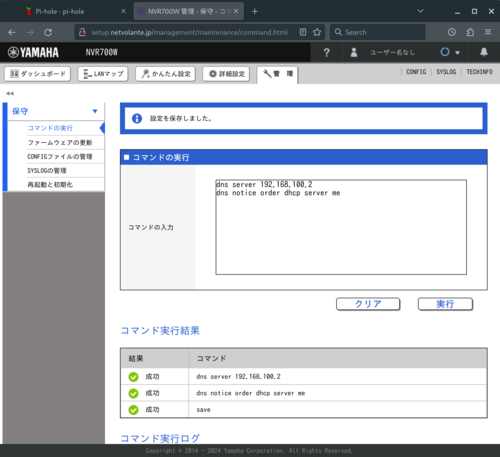
Be careful of commands order
For example, if you use nmcli to manage your network, and
you set the method to manual to fix the IP
address in the LAN, it ignores DHCP, so you can use the
command ipv4.dns 192.168.100.2 192.168.100.1 It
is the same as rewriting /etc/resolvd.conf, but
if there is a comment
# Generated by NetworkManager, it is better not
to write it directly.
If there is still an infidel in your LAN who ignores the Pi-Hole distributed by DHCP, you have to take direct action against him. You may think that IoT devices do not need to block advertisements, but the Pi-Hole is most useful for devices that cannot be configured in detail. Even if there are no advertisements, they may be secretly sending usage statistics, and only those devices that do so cannot be disabled from the settings.
Check privacy setting
You must respect the privacy of others. If the network is used by people other than yourself, information about what kind of request was made from which device should not be visible after debugging is complete. However, even if the information is hidden from the Web UI, it will remain in the log of the system.
Add blocklists
However, I think a loose rule is better than too strict and useless one, so I’ve not changed from the Pi-Hole’s default StevenBlack / hosts. Besides, it is safer to adapt to the majority of users because too much customization can cause fingerprinting.
Even if ads can be blocked, YouTube ads cannot be blocked by DNS, and ads on the Web may soon be made impossible to erase. And since I can’t use it when I’m away from home, I think it should be controlled on the device side. If I have to use a VPN to relay my home when I am out of the house, it will become more and more difficult to understand, and security will be far beyond the control of an amateur.
Conclusion
The battle against advertising is almost like a battle against technology itself. Every day we are beaten to a pulp by the technology produced by the front-line engineers of giant corporations.
I feel that Pi-Hole is not a means to “win” such an impossible war, but at least a means to prolong the life of a network that is infested with inconvenience and to bring back the good old freedom.
If you like computers and networking and want to try something new, why not install one in your home? Let’s look at “blocked” and “cached” and grin.
Changelog
: Concised some complicated sentenses. Fixed some typos and mistranslations.
AMDチップ搭載のシンクライアント端末「t420 Thin Client」が1,500円!中古品セール - AKIBA PC Hotline!↩︎
However, some sites have a policy of completely blocking connections using Google or Cloudflare DNS. Here is a website of a well-known Japanese researcher. | Welcome to the E-ONTAP↩︎
Although you want to connect directly “DNS resolver-DNS server”, it will become the “DNS resolver-DNS recursive server-DNS server” connection, which generate unnecessary traffic.
This is because a dedicated router is considered more fault-tolerant than a PC (thin client). Yamaha’s NVR can deliver a total of 4 DNS server addresses, but only 3 nameservers can be registered in the
resolvd.confof Linux, so even if I add Pi-Hole to have redundancy, it would be only one more.↩︎
